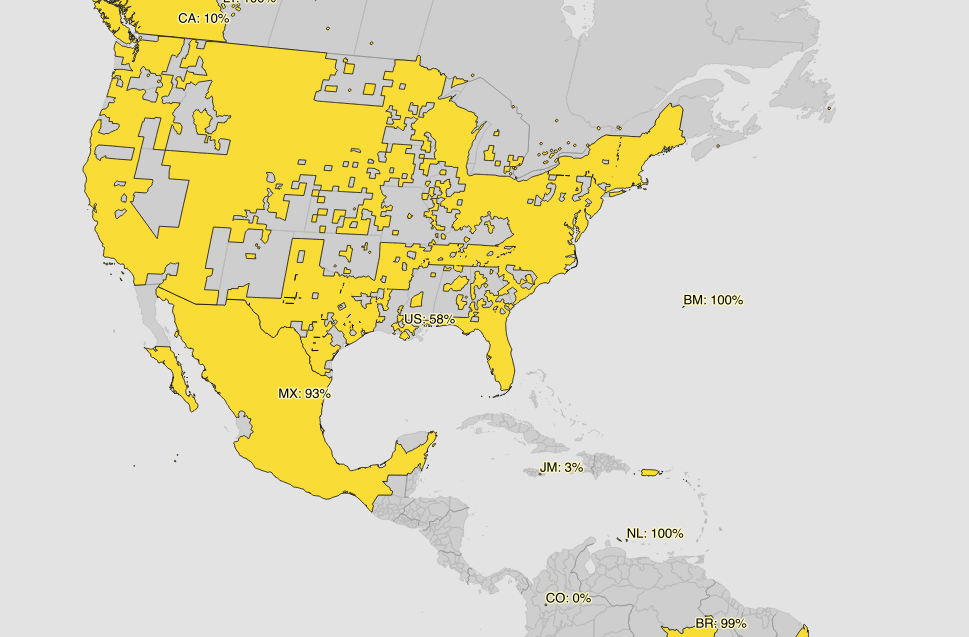-
Notifications
You must be signed in to change notification settings - Fork 5
New issue
Have a question about this project? Sign up for a free GitHub account to open an issue and contact its maintainers and the community.
By clicking “Sign up for GitHub”, you agree to our terms of service and privacy statement. We’ll occasionally send you account related emails.
Already on GitHub? Sign in to your account
Generate better coverage data #14
Comments
|
That Mapbox map is in dire need of visual design help. |
|
Making some progress on this in |
|
I <3 those colors. |
|
Cool! Reminds me about those funky Natural Earth concordances I need to fix.
… On Mar 8, 2017, at 16:58, Ian Dees ***@***.***> wrote:
I <3 those colors.
―
You are receiving this because you are subscribed to this thread.
Reply to this email directly, view it on GitHub, or mute the thread.
|
|
I have a temporary representation of this data here: http://ec2-54-89-13-7.compute-1.amazonaws.com Feedback at this stage would be really helpful! |
|
Nice! I like the addition of the population map at the bottom.
I continue to think the break from substantial and minimal should be
somewhere in the 10% to 20% range.
…On Tue, Mar 14, 2017 at 12:56 PM, Michal Migurski ***@***.***> wrote:
I have a temporary representation of this data here:
http://ec2-54-89-13-7.compute-1.amazonaws.com
Feedback at this stage would be really helpful!
—
You are receiving this because you are subscribed to this thread.
Reply to this email directly, view it on GitHub
<#14 (comment)>,
or mute the thread
<https://github.com/notifications/unsubscribe-auth/AA0EO3E692s3IwRv1j1B4V3WUPjfMsvCks5rlvEIgaJpZM4IXoCU>
.
|
|
The text in the intro helps explain the 3 parts of the table, but if you breeze over that it's not clear why the table parts are grouped that way. Might also add a column for the overall coverage grade (full, substantial, minimal)? This would allow future sorting of the table, too. |
See @nvkelso’s suggestions in openaddresses/openaddresses-ops#14 (comment)
|
Good ideas, I incorporated them all. |
|
This looks great, thanks for putting it together! The columns are a tiny bit confusing, though. maybe the "population in land area" column should be "population covered" or "estimated population covered"? |
|
Is there special HTML formatting that would allow these to copy into OpenOffice as a table? Right now I'd need to do processing to get it into a full table (as Land Area Covered, Population Covered, and Address Density all have sub cells that copy into 1 generic OpenOffice cell): So instead A-G it'd be 3 more for A-J. |
|
I was thinking of this with the "new" variant from the comment above, with separate columns for the parenthesized parts. I'll push it live; tell me if it works for you. |
|
✨ Spreadsheets! ✨ |
|
Now add a save as DBF option ;) JK!
… On Mar 14, 2017, at 15:22, Michal Migurski ***@***.***> wrote:
✨ Spreadsheets! ✨
—
You are receiving this because you are subscribed to this thread.
Reply to this email directly, view it on GitHub, or mute the thread.
|
|
After some good brainstorming with @sbma44 and Michael Steffen, I’m going to dumb down the address density number a little. It’s currently the average of densities (with standard deviation) and I’m going to simplify it to the average density so the arithmetic is easier to understand. |
|
Loving this work. My requests:
|
|
Good suggestions, @NelsonMinar. I’ve applied them all except the font thing. Can you tell what font is actually being rendered on Windows? It’s not Palatino, which looks like this for me: |
|
You're right, I think it's actually Georgia that my sample is showing (second option in the CSS for body). My Windows 10 system doesn't have a font named "Palatino", but it does have "Palatino Linotype" which seems to work in the CSS and looks OK. |
|
This is real now: http://results.openaddresses.io/coverage |
|
Congrats, great new feature :)
…On Wed, Mar 22, 2017 at 2:43 PM, Michal Migurski ***@***.***> wrote:
This is real now: http://results.openaddresses.io/coverage
—
You are receiving this because you were mentioned.
Reply to this email directly, view it on GitHub
<#14 (comment)>,
or mute the thread
<https://github.com/notifications/unsubscribe-auth/AA0EO5M3qQxAZtc813osFrWJTQfDaLfpks5roZX4gaJpZM4IXoCU>
.
|
|
👏 This is really excellent. I tweeted about it here: https://twitter.com/openaddr/status/844666719209750528 Can we add a map like the green/red one on https://results.openaddresses.io/ but coloring countries based on population coverage percentage? |
|
Yes, absolutely! I probably shouldn't use the same colors for this. |
|
These coverage metrics are the best thing ever. Also wondering if raw counts of addresses by country are maintained some place or if that would be useful to anyone besides me. |
|
That sounds pretty useful. Maybe a thing to put on a linked page for each country, as @michaelsteffen has suggested. |









Companies like Google and HERE produce coverage summaries of their data:
We’ve got a visual version of this in the maps at https://results.openaddresses.io, but a tabular form might be useful as well.
The text was updated successfully, but these errors were encountered: